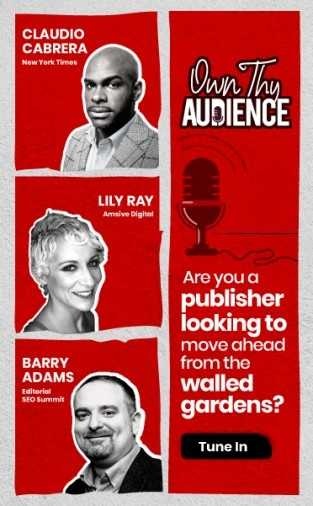Over the past decade, digital news publishing subscriptions have surged. According to a study by the Shorenstein Center of Harvard Kennedy School, about 60% of publishers limit their metered paywalls to five articles or less per month. This indicates a shift from depending on ad revenue alone. What has influenced this shift is the realization among news publishers of the potential of unique, reliable, and good-quality content. If your news content is appreciated by your audience, this is the right time to monetize content using paywalls.
Simply put, a paywall is a digital gate placed in front of your website's content. To unlock this gate, users need to either make a one-time payment or subscribe to your website. Paywalls restrict access to content by prompting visitors to pay to view the content. Generally, a paywall works based on a subscription model. Users are offered the choice to either pay monthly, per article or annually in order to gain access to the restricted content.
Also Read: 17 Best Paywall Solutions for Publishers
How does a paywall work?
The technology behind paywalls used by news publishers is as follows. First, subscription-based news portals focus on blocking non-paying IP addresses. The first barrier to reading content is a paywall login page. The paywall then verifies subscribers and allows authenticated users to access the content.
The encryption, authentication, and coding system of the paywall could differ based on its type.
Types of Paywalls
| Hard | Soft | Freemium | Dynamic | Ad-block | |
| Offering | All content is blocked | Limited content is free | Premium content is restricted. Rest is free. | Content restriction based on user behavior | Content is visible only if an ad blocker is disabled |
| Pros | Impossible to get around hard paywalls | Reaches a majority of casual visitors | Caters to all visitors | Better insight on users likely to become subscribers | Allows communication with ad-blocked audience |
| Cons | Casual users exit the site | A small percentage of users turn into paid subscribers | Only a subset of premium content is monetized | Difficult to implement when compared to hard or metered paywalls | Users disregard whitelist requests, resulting in high site abandonment |
| Examples | The Times Financial Times |
The New York Times | The Guardian | The New York Magazine | Huffpost |
Hard Paywalls
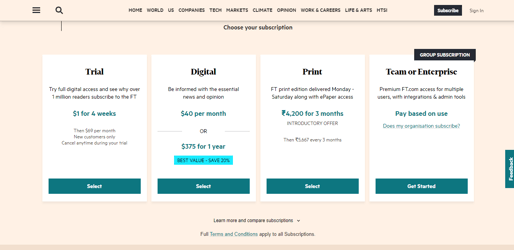
All content is blocked in a hard paywall. Only subscribers gain access to content. Visitors to the website can only see the title and subtitle of the post. This generates desire and curiosity among readers. However, this approach may not work for publishers that do not have an established brand and loyal audience.
Soft Paywalls
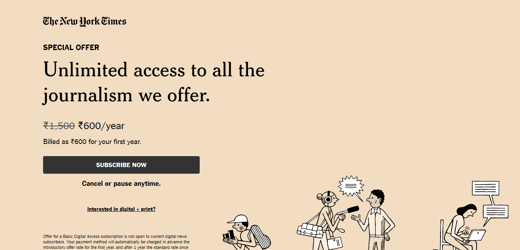
A Soft Paywall is the most popular paywall approach implemented by news websites. Here, readers can access a certain number of content pieces before getting restricted by the paywall. Publishers generally offer a fixed number of free articles before asking the user to pay or subscribe to their news site.
Freemium Paywalls
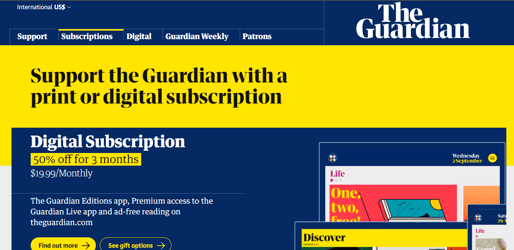 Some publishers selectively restrict access to premium content. The majority of the content is unrestricted. eMarketer uses this method by making report summaries and articles available for free. But it requires consumers to pay for the complete reports. Publishers can use both ad-supported and subscription-based revenue sources with the freemium paywall. As a result, they have something to offer to all types of users based on their specific content consumption preferences.
Some publishers selectively restrict access to premium content. The majority of the content is unrestricted. eMarketer uses this method by making report summaries and articles available for free. But it requires consumers to pay for the complete reports. Publishers can use both ad-supported and subscription-based revenue sources with the freemium paywall. As a result, they have something to offer to all types of users based on their specific content consumption preferences.
Dynamic Paywalls
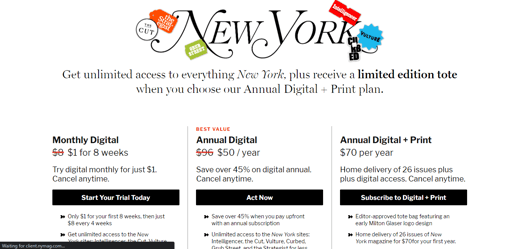 Paywalls, both hard and metered, are based on basic formulas that determine when the paywall should emerge. Dynamic paywalls go even further, displaying subscription requests and pop-ups when a visitor has a higher likelihood of becoming a paying subscriber. This is done by analyzing user behavior: frequency, reading habits, and interests using algorithms. Dynamic paywalls can be seen in the New York Magazine.
Paywalls, both hard and metered, are based on basic formulas that determine when the paywall should emerge. Dynamic paywalls go even further, displaying subscription requests and pop-ups when a visitor has a higher likelihood of becoming a paying subscriber. This is done by analyzing user behavior: frequency, reading habits, and interests using algorithms. Dynamic paywalls can be seen in the New York Magazine.
AdBlock Paywalls
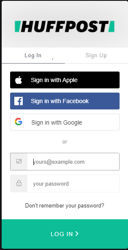 The majority of publishers have an ad block rate of 10-40%. Not having a strategy in place to engage this demographic means losing money. Setting up an "AdBlock wall" is one way that allows publishers to engage with the AdBlock audience to educate users about the importance of advertising revenue for businesses. This can be used to motivate them to whitelist a website. If the user agrees to the whitelist request, the publisher can continue to serve ads and earn money.
The majority of publishers have an ad block rate of 10-40%. Not having a strategy in place to engage this demographic means losing money. Setting up an "AdBlock wall" is one way that allows publishers to engage with the AdBlock audience to educate users about the importance of advertising revenue for businesses. This can be used to motivate them to whitelist a website. If the user agrees to the whitelist request, the publisher can continue to serve ads and earn money.
Have a perspective that can benefit our audience? Write for iZooto. Read this to know more about how you could get started.
How to add a Paywall to your News Website?
There are various ways in which businesses can build a paywall:
1. Plugins
If your news website is based on WordPress, then plugins are a great way to get started. We've compiled a list of the best paywall plugins for WordPress for you to get started.
2. Subscription management software
Products such as LaterPay, MediaPass, and Pelcro, allow you to customize and automate your paywall configuration.
3. Developers
You can also decide to go the customized route by hiring developers to build a paywall for your website.
Benefits of Paywalls for News Publishers
News publishers can generate a consistent revenue stream independent of ad revenue. Moreover, annual subscriptions have the potential to generate more money than monthly advertising campaigns.
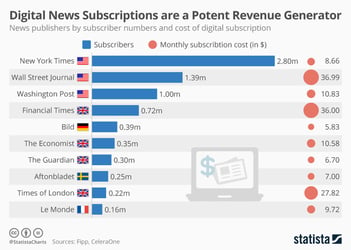
1. Increase in revenue
The Information, a tech news site launched in 2013 grew to 20,000 paying members in just three years. Each subscriber contributes $399 per year to access its content.
2. Data collection
You can discover more about your readers by tracking how many pieces they read before joining and which articles eventually lead them to become members. This can help you understand what your readers look for and help you in writing better content.
3. Subscription growth
When users sign up for paid content, you can collect their email addresses and offer personalized content that keeps them engaged. Wired, a popular news platform, reported a 300 percent rise in digital subscriptions in the first year after implementing a paywall.
4. Authority Building
Content that people pay for immediately gains a sense of exclusivity and importance. Readers today are willing to pay to be a part of a select group that receives information and guidance from an expert. Hence, applying a paywall to your news website can help you improve your brand authority.
5. Brand Promotion
Investing in a paywall is more than just charging for content. It entails a more substantial commitment to treating digital as the primary channel in the publication's strategy. This action can strengthen the brand's ties with readers while also setting it apart from the competition when done right.
How much does an average subscription cost?
According to an American Press Institute survey of 98 US news organizations, the average price for a digital subscription was $3.11 per week. Publishers that employed a metered model-averaged $2.97, freemium models averaged $3.52, and employing a hard paywall model-averaged $4.43.
Increasing Subscriber Engagement
To promote interaction among audiences and subscribers, the best-performing publishers employ content strategy, social media engagement, offline events, videos, emails, newsletters, and site optimization. As a general rule, every audience engagement activity that occurs prior to the subscription should continue after the subscription.
Some best practices for a paywall according to Lenfest Institute for Journalism are listed below:
1. Establishing a Focused Content Strategy
Content strategies are vital in both engaging and retaining subscribers. While social virality appears to be promising, the opposite may be true — articles with fewer social shares or page views may be more popular with subscribers than with general audiences.
2. Site Recirculation
The site recirculation technique allows publishers to develop more engaging interactions by evaluating how to best encourage a specific visitor to read the next piece. Recirculation is a real-time indicator that calculates how many people moved from one content piece on your website to another. Using this metric can help news publishers identify their audience’s behavior.
3. Stay in touch with local content
Publishers that produce more local (and non-wire-sourced) stories have higher subscription sales among the news publications analyzed. Defining the local news's distinctive value proposition may prove to work in favor of news publishers.
4. Create unique content
News publishers should focus on offering a unique value proposition to readers and offer them insights and information that is not easily available.
5. Re-engage your audience
Effective publishers help readers develop a "habit of news"; the best publishers provide readers with perspectives that encourage people to revisit and read frequently.
Challenges faced
Most publishing platforms face an uncertain future - more so if they continue the same practices followed over the past decades. In the case of reputed newspapers with a legacy, paywalls are more effective. Newspapers that provide unique and niche content also find success when they implement paywalls.
For most publishers, digital subscription revenue is offset by a significant decrease in digital advertising revenue caused by reduced website visits. Hence, the net effect of a paywall on digital sales is negative for most print media companies.
Key takeaways
Paywalls allow news organizations to generate revenue without relying on digital advertising. News Paywalls can help media companies survive and thrive in a free-market economy, where ad-blockers hurt ad revenue.
A successful digital subscription model is dependent on the ability to produce high-quality, unique content, recognize what readers prefer, and then restrict that content at suitable points for non-paying users. If you've never used a paywall before, you should start with a low-risk model and optimize your way up. With user browsing patterns evolving quickly, it's time for publishers to implement paywalls to monetize their website content.

